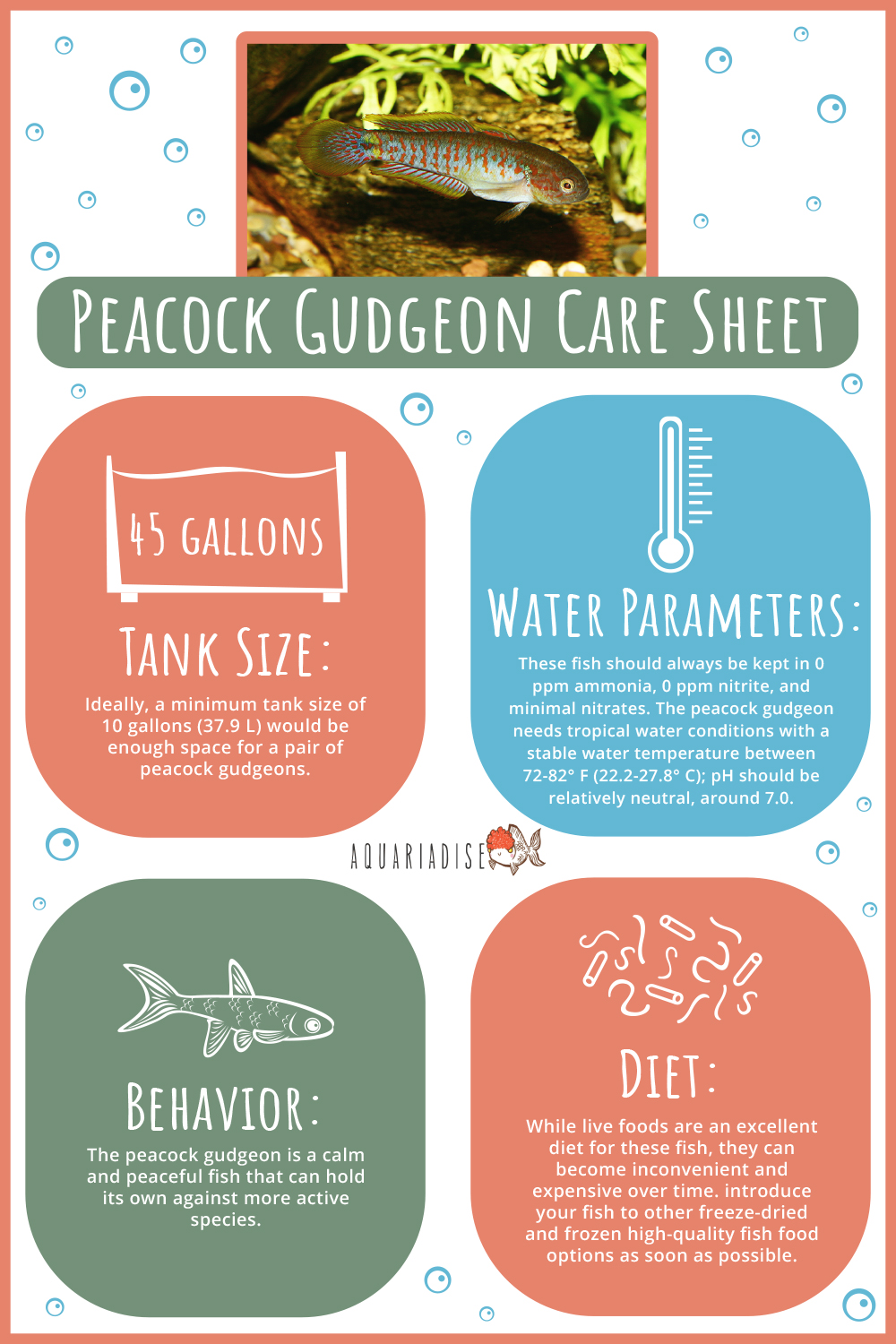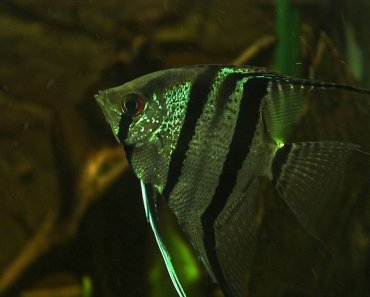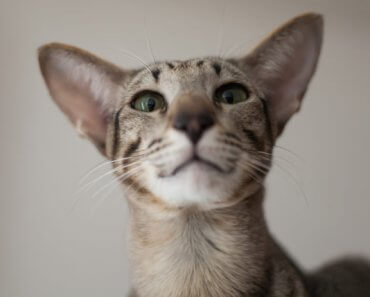A peacock gudgeon. Have you ever heard of it?
That’s okay! Many hobbyists have never heard of this small, colorful fish before, even though they’re one of the most beautiful fish species available.
It turns out, these gorgeous fish are perfect for smaller planted tanks and generally easy to care for in the long run.
Keep reading to find out everything you need to know about proper care for peacock gudgeon and if one of these fish would be a good addition to your freshwater aquarium!

Name
Tateurndina ocellicauda, more commonly known as the peacock gudgeon, is sometimes misnamed as the peacock goby. The peacock gudgeon belongs to the Eleotridae family of fish known as sleeper gobies or gudgeons.
The main difference between gudgeons and true gobies is that gudgeons do not have a fused pectoral fin (the fins right next to the fish’s gills.)
The peacock gudgeon is one of the smallest freshwater fish species in the Eleotridae family and one of the most vibrant.
Natural habitat
This peaceful fish species has a very limited range and are only endemic to eastern regions of Papua New Guinea. It is also believed that some populations have become established in New Zealand and Australia.
Not much is known about their preferred natural conditions, but they are typically found in shallow bodies of water in tropical rainforests.
Peacock gudgeons have also been observed in shoals, which we’ll discuss later.
Identification
Peacock gudgeons are sometimes called peacock gobies because they look almost exactly like a type of goby!
These fish have long, slender bodies with wide dorsal and anal fins. The most noticeable feature of this stunning fish is its vibrant colors.
Peacock gudgeons are named after their intense blues, reds, oranges, and yellows, reminiscent of peacock feathers. The body is usually light blue with red-orange vertical stripes; this patterning continues onto the fins, which have a strong yellow margin.
Males are typically more colorful than females, especially during spawning times. Males will also develop a hump on their heads, known as a nuchal hump, as they mature.
The female peacock gudgeon is smaller with duller colorations but will develop a yellow belly when ready to breed. Juvenile fish can be distinguished from young males by looking for a black margin on their anal fins.
How big do peacock gudgeons grow?
Peacock gudgeons are considered a nano species and only grow to an average size of 2-3 inches (5.1-7.6 cm) when fully grown; remember that adult males’ maximum size is slightly larger than females.
Peacock gudgeon tank requirements
As a nano species, the peacock gudgeon doesn’t need a larger tank to thrive.
Peacock gudgeons will do great in a heavily planted aquarium with good coverage and a natural scape with rocks and driftwood. Though it might seem contradictory, these fish are actually bolder when given plenty of caves and hiding spots.
What tank size do peacock gudgeons need?
Ideally, a minimum tank size of 10 gallons (37.9 L) would be enough space for a pair of peacock gudgeons.
Some hobbyists have had luck keeping these fish in much smaller tanks, but only seasoned hobbyists should attempt a 5 gallon (18.9 L) setup. If you want to keep more peacocks in bigger shoals or with other schooling fish, then a 20 gallon (75.7 L) tank is recommended.
These fish will stay in the middle water column and towards the bottom of the tank and aren’t known to be jumpers (though you should always have a tight lid on your aquarium!). Fine gravel or sand will also help keep your peacocks from injury.
Good filtration and regular tank maintenance including regular water changes are a must. Otherwise, these fish don’t require any special setup or conditions.
Water parameters
Peacock gudgeons need ideal water parameters to show their best colors.
These fish should always be kept in 0 ppm ammonia, 0 ppm nitrite, and minimal nitrates. The peacock gudgeon needs tropical water conditions with a stable water temperature between 72-82° F (22.2-27.8° C); pH should be relatively neutral, around 7.0.
Even though these fish might seem like a more advanced species to keep based on their colors and price, they are pretty hardy and can withstand less-than-ideal water quality. Meeting their needs will result in their best colors and personalities, though.
Peacock gudgeon tank mates
Overall, peacock gudgeons are a community species and can be kept with an assortment of fish in a community aquarium.
If you want to go for a biotope setup, other species from Papua New Guinea are preferred, like Pseudomugil and endemic species of rainbowfish.
Otherwise, you can keep peacock gudgeons with a wide variety of preferred tank mates, like tetras, rasboras, and danios. Though these fish might seem like easy prey, some hobbyists find that they can hold their own against more aggressive fish, like gouramis and ram cichlids.
Bad tank mates include fish that live near the bottom of the tank, as this might make your peacock hide more often.
Are peacock gudgeons schooling fish?
While peacock gudgeons aren’t schooling fish in the sense that they’ll tightly move around the tank like tetras, they do shoal together and greatly enjoy the company of other aquarium fish.
Along with additional hiding places, having more peacocks in your tank will encourage your fish to come out and show itself.
Though some hobbyists like to keep only one female for every male, we recommend at least two females per male to keep stress levels down.
Peacock gudgeon behavior
The peacock gudgeon is a calm and peaceful fish that can hold its own against more active species.
If placed in an incorrect tank setting with poor tank mate choices, they will usually hide from larger fish wherever they can and rarely be seen. Otherwise, they can be found idling above the substrate, looking for food.
Are peacock gudgeons aggressive?
Generally, no.
These beautiful freshwater fish may become slightly aggressive to other peacocks, especially males, during spawning periods. This aggression between males will pass. But, if it does not, consider adding more females to the tank or making new hiding places.
Peacock gudgeon diet
The potentially hardest part about keeping a shoal of peacock gudgeon is that they’re known to be slightly picky eaters. That shouldn’t deter you from trying to keep this species in your freshwater tank, though!
There are many opinions on the peacock gudgeon diet. Some hobbyists think they’re one of the most challenging species to feed, while others can feed their fish a mixed diet of anything they want.
For the most part, the latter is true. And if your fish doesn’t eat what you have to offer, you will have to broaden its appetite.
The problem with peacock gudgeons is that they are micro-predators and will be eager to eat anything that’s moving. Peacock gudgeons almost always prefer live foods over anything else.
While live foods are an excellent diet for these fish, they can become inconvenient and expensive over time. Instead, you will want to introduce your fish to other freeze-dried and frozen high-quality fish food options as soon as possible.
It’s simple enough; you just need to break your fish’s live food habits.
Start by fasting your fish and offering new food. Eventually, your fish will come to accept this different food, at which point, you may completely transition over or supplement with the old food as well.
A good peacock gudgeon diet will consist of high-protein live, frozen, and freeze-dried daphnia, baby brine shrimp, and bloodworms. A high-quality diet of flake food or pellets will also help deter costs while keeping your fish happy and healthy.
You should note that peacock gudgeons will eat any baby fish in the aquarium, including those of other fish and invertebrates.
Peacock gudgeon breeding
These fish have an interesting breeding ritual similar to how plecos reproduce. Peacock gudgeons use caves to shelter and look after their eggs.
Peacock gudgeons are relatively easy to breed and will willingly do so under the right conditions. Parental care stops after the eggs have hatched, so it may be worthwhile moving the mated pair into a separate breeding tank for safety and a better success rate with raising fry.
Once a breeding pair has been established, watch for a yellow patch on the female’s belly and displays by the male in front of a preferred cave or other safe spawning area.
The female adult fish will lay her eggs in the cave, and the male will fertilize them. The female has finished her mating responsibilities, and the male will continue to take proper care of the eggs from there; you may see him fanning the eggs and chasing away other fish.
Once these eggs hatch after a couple of days, the male will stop caring for them entirely. At this point, it is best to remove all potential predators from the tank, including the male parent.
The fry will become free-swimming a few days after that. You can feed them small, nutritious high protein food until they’re ready to be moved into the display tank or sold to another hobbyist.
Conclusion
The peacock gudgeon is an uncommon species to encounter in the fish community but is full of color and personality. Though these fish can be initially expensive, they are very low-maintenance, relatively easy to breed, and have become a favorite community tank fish.
If you have any questions about peacock gudgeons, gobies, or gudgeons, or have had experience keeping this beautiful species of fish before, don’t hesitate to leave a comment below!

![Say “Ciao” [Hello] to the Bracco Italiano Say “Ciao” [Hello] to the Bracco Italiano](https://petsforchildren.com/wp-content/uploads/2023/03/say-ciao-hello-to-the-bracco-italiano-370x297.jpg)























